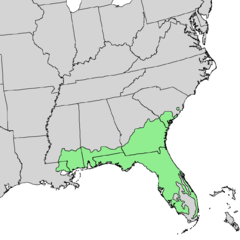Pinus elliottii
| Pinus elliottii | |
|---|---|
.jpg) | |
| Scientific classification | |
| Kingdom: | Plantae |
| Division: | Pinophyta |
| Class: | Pinopsida |
| Order: | Pinales |
| Family: | Pinaceae |
| Genus: | Pinus |
| Subgenus: | P. subg. Pinus |
| Section: | P. sect. Trifoliae |
| Subsection: | P. subsect. Australes |
| Species: | P. elliottii |
| Binomial name | |
| Pinus elliottii | |
| Varieties | |
|
Pinus elliottii var. elliottii | |
 | |
| Generalized natural range of Pinus elliottii | |
Pinus elliottii, commonly known as the slash pine,[2] is a pine tree native to the southeastern United States. Slash pine is named after the "slashes" – swampy ground overgrown with trees and bushes – that constitute its habitat.
Range and habitat
It is found from southern South Carolina west to southeastern Louisiana, and south to the Florida Keys.[3] It natural habitat is sandy subtropical maritime forests and wet flatwoods.[4]

Communities dominated by slash pine are termed "slash pine forests". These forests have been managed through controlled fires since the beginning of the twentieth century.
Description
This tree is fast-growing, but not very long-lived by pine standards (to 200 years). It reaches heights of 18–30 m (59–98 ft) with a trunk diameter of 0.6–0.8 m (2.0–2.6 ft). The leaves are needle-like, very slender, in clusters of two or three, and are 18–24 cm (7.1–9.4 in) long. The cones are glossy red-brown, 5–15 cm (2.0–5.9 in) in length with a short (2–3 mm or 0.079–0.118 in), thick prickle on each scale. It is known for its conical shape.
It may be distinguished from the related loblolly pine (Pinus taeda) by the somewhat longer, glossier needles and larger red-brown cones, and from longleaf pine (Pinus palustris) by the shorter, more slender needles and smaller cones with less broad scales.
Taxonomy
There are two described varieties of Pinus elliotii. However, recent genetic studies have indicated that the varieties may not be more closely related to each other than they are to other pines in the Southeast. If this is the case, then status as separate species would be warranted.[4] This treatment has not been widely adopted.
The two commonly accepted varieties are the following:
- P. elliottii var. elliottii (typical slash pine) ranges from South Carolina to Louisiana, and south to central Florida. Its leaves are in bundles (fascicles) of twos and threes, mostly threes, and the cones are larger, 7–15 cm (2.8–5.9 in).
- P. elliottii var. densa (South Florida slash pine, Dade County pine) is found in the pine rocklands of southern Florida and Florida Keys, including the Everglades.[5][6] Leaves nearly all in bundles of two. Cones smaller, 5–12 cm (2.0–4.7 in).
Unlike the typical variety of slash pine, seedlings of P. elliottii var. densa pass through a "grass stage", in a manner similar to longleaf pine.
Uses
This tree is widely grown in tree plantations. It is also used in horticulture.
See also
References
- ↑ Conifer Specialist Group (1998). "Pinus elliottii". IUCN Red List of Threatened Species. Version 2006. International Union for Conservation of Nature. Retrieved 10 May 2006.
- ↑ Kral, Robert (1993). "Pinus elliottii". In Flora of North America Editorial Committee. Flora of North America North of Mexico (FNA). 2. New York and Oxford – via eFloras.org, Missouri Botanical Garden, St. Louis, MO & Harvard University Herbaria, Cambridge, MA.
- ↑ Moore, Gerry; Kershner, Bruce; Craig Tufts; Daniel Mathews; Gil Nelson; Spellenberg, Richard; Thieret, John W.; Terry Purinton; Block, Andrew (2008). National Wildlife Federation Field Guide to Trees of North America. New York: Sterling. p. 74. ISBN 1-4027-3875-7.
- 1 2 "Flora of the Southern and Mid-Atlantic States".
- ↑ "Pine Rocklands" (PDF). United States Fish and Wildlife Service. Retrieved September 18, 2018.
- ↑ Gilman, Edward F.; Dennis G. Watson (2006). "Pinus elliottii: Slash Pine". University of Florida, Institute of Food and Agricultural Sciences. Retrieved 12 April 2011.
External links


